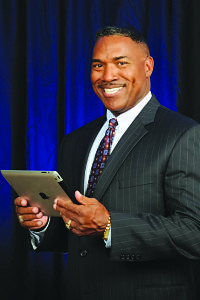Bringing High Tech to a Low-Income District
 As the superintendent of Coachella Valley Unified School District (CA), where 80 percent of the children live in poverty and 70 percent are English language learners, Darryl Adams spearheaded a successful bond measure that funded a 1-to-1 iPad initiative for Coachella Valley Unified’s 20,000 students. The district then began putting WiFi routers on idle school buses in areas where families lacked high-speed Internet connectivity. Last November, President Obama recognized Adams’ innovative efforts at a ConnectED to the Future meeting where fellow educators were discussing the importance of technology in education.
As the superintendent of Coachella Valley Unified School District (CA), where 80 percent of the children live in poverty and 70 percent are English language learners, Darryl Adams spearheaded a successful bond measure that funded a 1-to-1 iPad initiative for Coachella Valley Unified’s 20,000 students. The district then began putting WiFi routers on idle school buses in areas where families lacked high-speed Internet connectivity. Last November, President Obama recognized Adams’ innovative efforts at a ConnectED to the Future meeting where fellow educators were discussing the importance of technology in education.
THE Journal: One of the first things you did after becoming superintendent in 2011 was to set in motion the 1-to-1 iPad initiative. What was the impetus for that?
Darryl Adams: Our students weren’t graduating prepared for college and I thought, “This is educational malpractice. We’ve got to do something different.” We knew we had to change our whole system, that we had to utilize every tool available, and one of the most important tools is technology. Why weren’t we using that?
THE Journal: You put a bond on the November 2012 ballot and ended up getting it passed with 67 percent of the vote. How did you build support in such a low-income community?
Adams: I almost felt like I was running for office myself! We knew it was expensive but we said, “Let’s go to the parents and ask whether it’s important enough for you to tax yourself so that your students will have it.” We did a pilot program with about 5,000 iPads to build interest and get the teachers, students and parents excited, then we put it on the ballot and the people said, “We’re not going to wait for the government or anyone else; we’re going to tax ourselves so our students have a better future.”
THE Journal: What were the challenges to implementing the program?
Adams: We had to train our teachers before the students got their devices. We had formed a group of about 120 who worked with the iPads and their students during the pilot phase, starting in January 2012, so we had time to make sure that our teachers were well versed in how to use the devices and that they would then help the other teachers see how important it was. Then we had to make sure we had the WiFi infrastructure to handle that many devices and that the connectivity was state-of-the-art, so we rebuilt the whole system from the funds that we got from the bond.
THE Journal: And then you realized you needed to do more than have the students connected at school?
Adams: It was a $42 million bond, and the initial $22 million went to buy the devices and rebuild the infrastructure. But what I was seeing was parents were bringing students in and parking at the school at night so they could connect, or parking at the district office on the weekends so that they could connect. We have a lot of trailer-home parks, and we knew that some students may not have connectivity there. About 30 to 40 percent were not connected. So we said, “Let’s put the router on the bus and park it in those non-connectivity areas when it’s not being used. At first we ran into a problem because the battery runs down — you can’t just leave the bus on — so we decided to put solar panels on the bus, and that’s worked out brilliantly.
THE Journal: Where does the WiFi bus initiative stand?
Adams: We’re just leaving the pilot phase. We have it on two buses now, but 100 buses will have routers when we finish in the next eight to 10 months. This isn’t a program designed to take money away from the big Internet service providers, it’s just to go into those communities that they’re not serving and do it ourselves — only for our students, because you have to go through our filter to get in. Now we are looking into becoming our own ISP. If there’s dark fiber through an area, why can’t the school district light that up and provide access to its students?
THE Journal: What difference has all this access made for Coachella Valley students?
Adams: It’s just off-the-charts unbelievable how students are engaged now, not because they’re looking at a screen all day but because they’re able to communicate, collaborate, create, research, critically think and find answers. The world has been opened up to them, and they’re energized now like never before. I call it the digital magic in the classroom. It’s really stunning to see what’s happening.
THE Journal: How did it feel to have President Obama recognize your efforts?
Adams: It wasn’t just me. It was a recognition that even in this poor community, there was enough collaboration and cooperation to ensure that all students were connected. That was a great day for all of us.